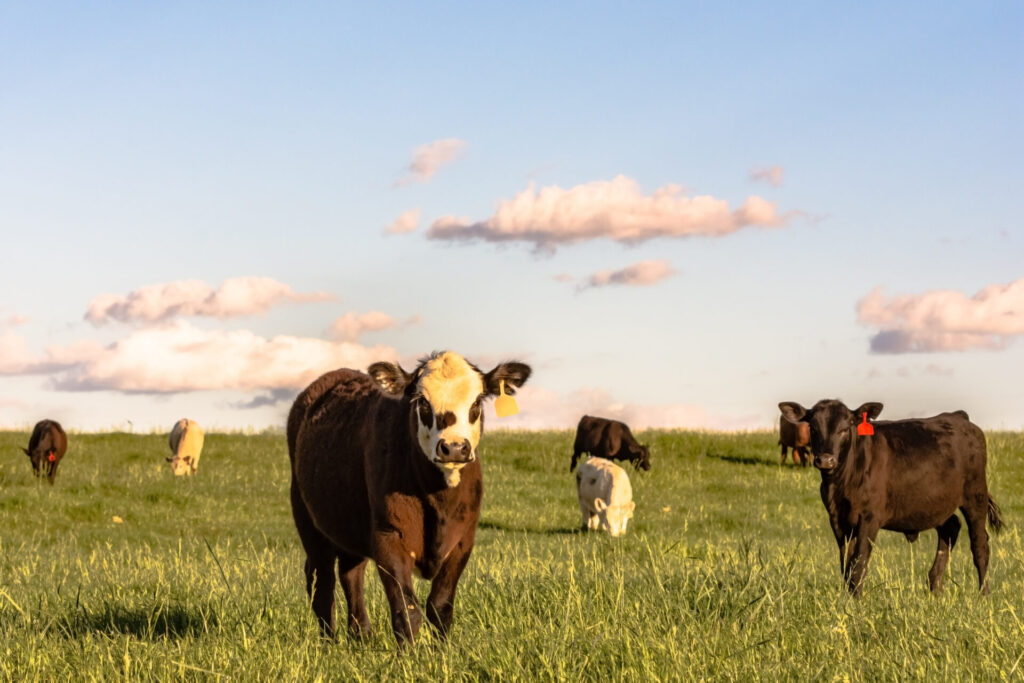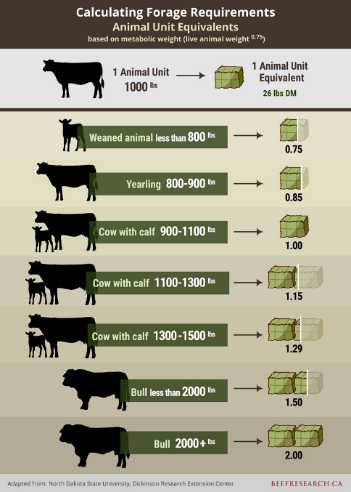Cracking the Code on Grazing Management Terminology: Animal Units, AUMs, & How to Apply Them

Does it feel like grazing management information is shrouded in acronyms and terms that boggle the mind on first glance? Do you struggle to decipher terms like animal unit equivalents? And how does one go about calculating AUMs and then applying those numbers? Be reassured, you’re not alone! There’s a lot going on when sorting through the finer points of grazing management and figuring out how to work through the many calculations.
A good starting point is defining a grazing animal in terms of how much forage it requires to meet its nutritional demands. We know that grazing animals’ forage needs differ depending on class, weight, age and stage of production. And in order to account for those differences, it’s helpful to create a baseline in order to quantify forage demand.
An animal unit (AU) is defined as a 1,000 lb beef cow with or without a nursing calf, with a daily dry matter forage requirement of 26 lbs. By standardizing grazing animals at 1,000 pounds as one animal unit (AU), we are able to use that as a basis for calculating the relative grazing impact of different kinds and classes of livestock. We can work off of one AU to adjust for other animal types.
Use the Calculating Forage Requirements chart to find the Animal Unit Equivalent (AUE) that best defines your grazing animals.
For example, yearlings ranging from 800-900 pounds are considered equivalent to 0.85 animal units (AUs) while a 1,400-pound cow, with calf at side, is considered to be 1.3 AUs. Essentially, the larger the animal and the greater their nutritional requirements, the higher the animal unit equivalent value.
With a clear picture in mind of an animal unit and its equivalents, the leap to quantifying forage demand with measures such as animal unit days (AUDs) or animal unit months (AUMs), is not difficult. If one AU requires 26 pounds of forage dry matter per day, we can then easily extrapolate to calculate the needs of any animal for a longer period of time.
An animal unit month (AUM) is the amount of forage to fulfill metabolic requirements of one animal unit for one month (30 days). Therefore, one AUM is equal to 780 lbs of dry matter forage (26 lbs/day x 30 days).
Think of an AUM as the amount of forage that you need to provide to an animal to maintain them for one month. But remember, that animal weighs only 1,000 pounds. Anything more, or less, has to be accounted for by using animal unit equivalents (AUEs).
Once you are comfortable with these standardized units, they become very useful tools to strategize and plan for various grazing options. Consider the following scenarios as examples of how you might use animal unit equivalents to begin the groundwork for grazing management strategies on paper before applying them in real time.
- A herd of 150 cow-calf pairs averaging 1,400 pounds (1.3 animal unit equivalent; see chart above), equals 195 animal units (150 pairs x 1.3 AUE = 195 AUs)
- A group of 150 yearlings, weighing an average of 850 pounds (0.85 animal unit equivalent; see chart above), equates to 128 animal units (150 yearlings x 0.85 AUE = 128 AUs)
- If you want to graze that 150 pair cowherd (195 AUs) for 6 months, pasture acres must be available that can supply a total of 1170 AUMs (195 AUs x 6 months = 1170 AUMs)
- If grazing 150 yearlings (128 AUs) for 6 months, total forage demand is 768 AUMs (128 AUs x 6 months = 768 AUMs)
Calculating and understanding forage requirements allows us to be able to match that demand up with available forage supply. The BCRC Carrying Capacity Calculator helps with that. It walks users through estimating available forage to determine the number of head and length of time that animals can graze a specific pasture or paddock.
Remember that these values are all approximations and averages; we are using numbers to estimate and standardize what happens in reality to guide informed decision making for your operation. It is important to note that there many factors at play when managing and balancing grazing demand and available forage supply. The real world always overrides what calculations attempt to predict but, they can provide a starting point for planning and forecasting.
You’ve now got a few of the basics in hand to understand the foundations of the art and science of grazing management. It is this critical information that will assist as you navigate real world situations like developing targeted grazing plans, implementing rest periods or managing through drought and recovery.
To take the next steps in applying this information or to expand your knowledge, visit these resources:
- BCRC Carrying Capacity Calculator
- Grazing Management (BCRC webpage)
- Rangeland & Riparian Health (BCRC webpage)
Click here to subscribe to the BCRC Blog and receive email notifications when new content is posted.
The sharing or reprinting of BCRC Blog articles is welcome and encouraged. Please provide acknowledgement to the Beef Cattle Research Council, list the website address, www.BeefResearch.ca, and let us know you chose to share the article by emailing us at info@beefresearch.ca.
We welcome your questions, comments and suggestions. Contact us directly or generate public discussion by posting your thoughts below.
